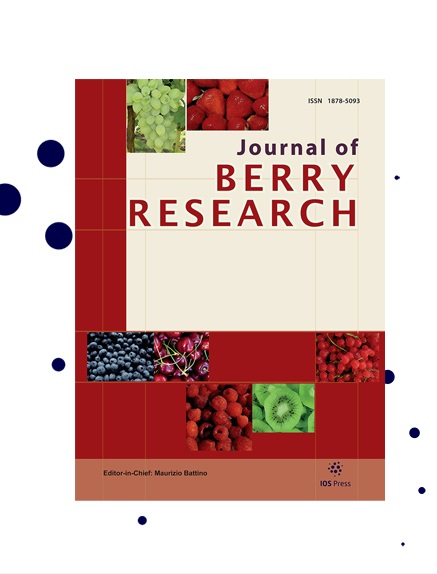R2R3-MYB基因家族的鉴定揭示了基于RNA-seq数据的金银花花青素生物合成候选基因
IF 1.4
4区 农林科学
Q3 PLANT SCIENCES
引用次数: 0
摘要
背景:R2R3-MYB转录因子(TF)家族在许多植物的各种生物学过程中发挥着重要作用,尤其是在调节植物类黄酮积累方面。青叶忍冬果实中含有丰富的花青素。目的:根据RNA-seq数据对R2R3-MYB TF家族进行系统分析,筛选出参与蓝忍冬果实花青素生物合成的R2R3-MYB候选基因。方法:对金银花中R2R3-MYB转录因子进行鉴定,并利用生物信息学方法对其理化性质、蛋白质保守序列比对和基序进行分析。采用RT-qPCR和pH偏移法测定了这些基因在果实不同组织和不同发育阶段的表达水平和花青素水平。结果:共鉴定出59个编码蓝毛忍冬R2R3-MYB转录因子的基因,并根据其与AtR2R3-MYB的关系分为20个亚群(C1至C20)。表达谱显示,CL6086和CL552在果实中的表达高于其他组织,并且与绿色成熟的果实相比,在白藜芦果实中上调。由于这两个基因的表达与花青素含量同时发生,并且与花青素生物合成结构基因高度相关,因此被认为与果实中花青素的生物合成密切相关。结论:该结果为蓝毛忍冬果实中LcR2R3-MYB的系统分析提供了依据,为进一步研究R2R3-MYB调控花青素生物合成的分子机制奠定了基础。本文章由计算机程序翻译,如有差异,请以英文原文为准。
Identification of R2R3-MYB gene family reveal candidate genes for anthocyanin biosynthesis in Lonicera caerulea fruit based on RNA-seq data
BACKGROUND: R2R3-MYB transcription factor (TF) family plays important roles in various biological processes in many plants, especially in the regulation of plant flavonoid accumulation. The fruit of Lonicera caerulea contains abundant anthocyanin. OBJECTIVE: The R2R3-MYB TF family was systematically analyzed according to the RNA-seq data, and the R2R3-MYB candidate genes that were involved in anthocyanin biosynthesis in the fruit of Lonicera caerulea were screened. METHODS: The R2R3-MYB TFs in Lonicera caerulea were identified, and the physical and chemical properties, protein conserved sequence alignment and motifs of each R2R3-MYB TFs were analyzed using bioinformatics methods. The expression levels of these genes and anthocyanin levels in different tissues and different developmental stages of fruit were determined by RT-qPCR and pH shift method. RESULTS: A total of 59 genes encoding R2R3-MYB TFs in Lonicera caerulea were identified and clustered into 20 subgroups (C1 to C20) based on the relationship to AtR2R3-MYBs. Expression profiles showed that the expression of CL6086 and CL552 in fruit were higher than other tissues, and upregulated in the veraison fruit compared to the green ripe fruit. As the expression of the two genes was concurrent with the anthocyanin content, and showed high correlation with anthocyanin biosynthetic structural genes, they were considered as closely related to anthocyanin biosynthesis in the fruit. CONCLUSION: The results provide a systematic analysis of LcR2R3-MYBs, and the foundation for further molecular mechanisms research of anthocyanin biosynthesis regulated by R2R3-MYB in the fruit of Lonicera caerulea.
求助全文
通过发布文献求助,成功后即可免费获取论文全文。
去求助
来源期刊

Journal of Berry Research
Biochemistry, Genetics and Molecular Biology-Biochemistry
CiteScore
3.50
自引率
11.80%
发文量
21
期刊介绍:
The main objective of the Journal of Berry Research is to improve the knowledge about quality and production of berries to benefit health of the consumers and maintain profitable production using sustainable systems. The objective will be achieved by focusing on four main areas of research and development:
From genetics to variety evaluation
Nursery production systems and plant quality control
Plant physiology, biochemistry and molecular biology, as well as cultural management
Health for the consumer: components and factors affecting berries'' nutritional value
Specifically, the journal will cover berries (strawberry, raspberry, blackberry, blueberry, cranberry currants, etc.), as well as grapes and small soft fruit in general (e.g., kiwi fruit). It will publish research results covering all areas of plant breeding, including plant genetics, genomics, functional genomics, proteomics and metabolomics, plant physiology, plant pathology and plant development, as well as results dealing with the chemistry and biochemistry of bioactive compounds contained in such fruits and their possible role in human health. Contributions detailing possible pharmacological, medical or therapeutic use or dietary significance will be welcomed in addition to studies regarding biosafety issues of genetically modified plants.
 求助内容:
求助内容: 应助结果提醒方式:
应助结果提醒方式:


